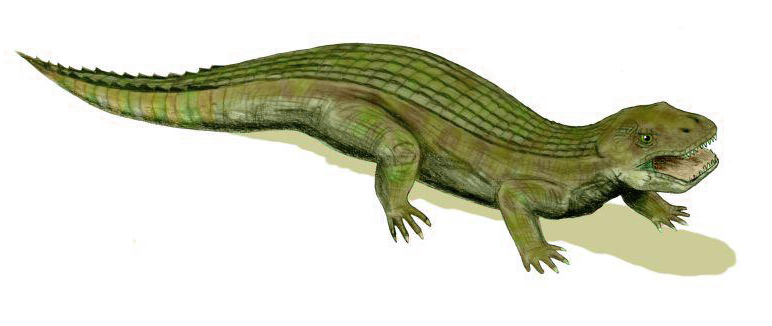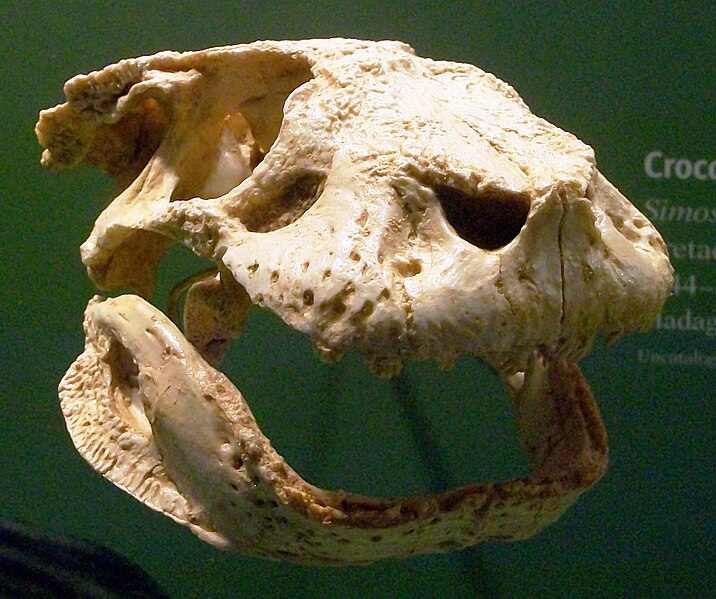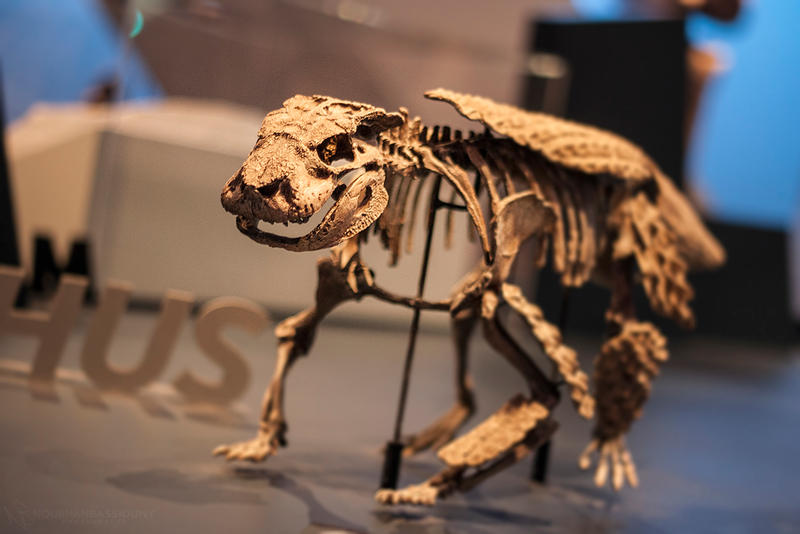[Recent Entries][Archive][Friends][User Info]
Below are the 2 most recent journal entries recorded in the "Сообщество, посвящённое ра" journal:| March 26th, 2014 | |
|---|---|
| 10:41 am [industrialterro] [Link] |
Simosuchus Simosuchus (meaning "pug-nosed crocodile" in Greek, referring to the animal's blunt snout) is an extinct genus of notosuchian crocodylomorphs from the Late Cretaceous of Madagascar. It is named for its unusually short skull. Fully grown individuals were about 0.75 metres (2.5 ft) in length. The type species is Simosuchis clarki, found from the Maevarano Formation in Mahajanga Province. The teeth of S. clarki were shaped like cloves (maple leaves), which coupled with its short and deep snout suggest it was not a carnivore like most other crocodylomorphs. In fact, these features have led many palaeontologists to consider it an herbivore. Simosuchus was small, about 0.75 metres (2.5 ft) long based on the skeletons of mature individuals. In contrast to most other crocodyliforms, which have long, low skulls, Simosuchus has a distinctively short snout. The snout resembles that of a pug, giving the genus its name, which means "pug-nosed crocodile" in Greek. The shape of skulls differs considerably between specimens, with variation in ornamentation and bony projections. These differences may be indications of sexual dimorphism. The front portion of the skull, or preorbital area, is angled downwards. Simosuchus likely held its head so that the preorbital area was angled about 45° from horizontal. The teeth line the front of the jaws and are clove-shaped. At the back of the skull, the occipital condyle (which articulates with the neck vertebrae) is downturned. 45 autapomorphies, or features unique to Simosuchus, can be found in the skull alone. In most respects, the postcranial skeleton of Simosuchus resembles that of other terrestrial crocodyliforms. There are several differences, however, that have been used to distinguish it from related forms. The scapula is broad and tripartite (three-pronged). On its surface, there is a laterally directed prominence. The deltopectoral crest, a crest on the upper end of the humerus, is small. The glenohumeral condyle of the humerus, which connects to the pectoral girdle in the shoulder joint, has a distinctive rounded ellipsoid shape. The limbs are robust. The radius and ulna of the forearm fit tightly together. The front feet are small with large claws, and the back feet are also reduced in size. There is a small crest along the anterior edge of the femur. On the pelvis, the anterior process of the ischium is spur-like. Most of the spinal column of Simosuchus is known. There are eight cervical vertebrae in the neck, at least fifteen dorsal vertebrae in the back, two sacral vertebrae at the hip, and no more than twenty caudal vertebrae in the tail. The number of vertebrae in the tail is less than that of most crocodyliforms, giving Simosuchus a very short tail. Like other crocodyliforms, Simosuchus was covered in bony plates called osteoderms. These form shields over the back, underside, and tail. Unusually among crocodyliforms, Simosuchus also has osteoderms covering much of the limbs. Osteoderms covering the back, tail, and limbs are light and porous, while the osteoderms covering the belly are plate-like and have an inner structure resembling spongy diploë. Simosuchus has a tetraserial paravertebral shield over its back, meaning that there are four rows of tightly locking paramedial osteoderms (osteoderms to either side of the midline of the back). To either side of the shield, there are four rows of accessory parasagittal osteoderms. These accessory osteoderms tightly interlock with one another. The first specimen of Simosuchus clarki, which served as the basis for its initial description in 2000, included a complete skull and lower jaw, the front of the postcranial skeleton, and parts of the posterior postcranial skeleton. Five more specimens were later described, representing the majority of the skeleton. Many isolated teeth have also been found in the Mahajanga Basin. Most remains of Simosuchus were found as part of the Mahajanga Basin Project, directed by the Université d'Antananarivo and Stony Brook University. Material was usually found in clays that were part of flow deposits in the Anembalemba Member of the Maevarano Formation. Simosuchus was first considered to be a basal member of the clade Notosuchia, and was often considered to be closely related to Uruguaysuchus from the Late Cretaceous of Uruguay and Malawisuchus from the Early Cretaceous of Malawi. Later phylogenetic studies have placed it closer to the genus Libycosuchus and in a more derived position than some other notosuchians such as Uruguaysuchus. In its initial description by Buckley et al. (2000), Simosuchus was placed in the family Notosuchidae. Its sister taxon was Uruguaysuchus, and the two were allied with Malawisuchus. These taxa were placed in Notosuchidae along with Libycosuchus and Notosuchus. Most of the following phylogenetic analyses resulted in a similar placement of Simosuchus and other genera within Notosuchia. Turner and Calvo (2005) also found a clade including Simosuchus, Uruguaysuchus, and Malawisuchus in their study. The phylogenetic analysis of Carvalho et al. (2004), based on different character values than previous studies, produced a very different relationship among Simosuchus and other notosuchians. Simosuchus, along with Uruguaysuchus and Comahuesuchus, were placed outside Notosuchia. Simosuchus was found to be the sister taxon of the Chinese genus Chimaerasuchus in the family Chimaerasuchidae. Like Simosuchus, Chimaerasuchus has a short snout and was probably herbivorous. Both genera were placed outside Notosuchia in the larger clade Gondwanasuchia. Uruguaysuchus, previously considered to be a basal notosuchian and a close relative of Simosuchus, was placed in its own family, Uruguaysuchidae, also outside Notosuchia. Malawisuchus was found to be a member of Peirosauroidea, specifically a member of the family Itasuchidae. Размеры тела в сравнении с человеком: Ископаемые останки (1, 2, 3, 4): Tags: Вымершие рептилии, Мел, архозавроморфы, архозавры, диапсиды, зифозухии, крокодиломорфы, круротарзы, мезоэукрокодилии, нотозухии, равизухии, химеразухиды |
| March 16th, 2014 | |
| 06:44 pm [industrialterro] [Link] |
Chimaerasuchus Chimaerasuchus ("chimera crocodile") is an extinct genus of Chinese crocodyliform from the Early Cretaceous. The four teeth in the very tip of its short snout gave it a "bucktoothed" appearance. Due its multicusped teeth and marked heterodonty, it is believed to have been an herbivore. Древние крокодилы, обитавшие на нашей планете вместе с динозаврами, были куда более широко распространены, чем сейчас. В те далекие времена среди них встречались и огромные океанические формы с плавательными перепонками на лапах, и наземные формы с длинными конечностями, которые могли бегать за своей добычей и даже лазать на деревья. Недавние находки ученых свидетельствуют о том, что в те времена жили на Земле даже крокодилы-вегетарианцы. Несколько лет назад в Китае были обнаружены останки мелкого крокодила мелового периода, который получил латинское имя Chimaerasuchus (крокодил-химера) благодаря своим весьма причудливым широким и тупым зубам, которые больше напоминали коренные зубы млекопитающих. Такие зубы да еще короткая тяжелая морда позволили предположить, что рептилия питалась растениями. В скором времени были сделаны и другие подобные находки. Другой крокодил мелового периода, найденный на Мадагаскаре и названный Simosuchus (от греч. simo – свиной нос, пятачок), обладал коротким квадратным рылом и округлыми зубами с зубчатым краем. Подобные зубы встречались у растительноядных динозавров, а сейчас их можно увидеть у игуан. Совершенно не удивительно, что в меловом периоде с его огромным разнообразием хищных рептилий некоторые крокодилы небольших размеров «решили», напротив, стать вегетарианцами. Хотя при этом им пришлось избегать встреч со своими более крупными и кровожадными сородичами. Chimaerasuchidae ("Chimera crocodiles") is a family of mesoeucrocodylians. It was erected as a clade in 2004 by Carvalho et al and included Chimaerasuchus from the Early Cretaceous of China and Simosuchus from the Late Cretaceous of Madagascar. The validity of the clade has been questioned in later studies that found the two genera to be more distantly related. In the phylogenetic analysis of Carvalho et al, the family contained Chimaerasuchus and Simosuchus, two genera of small (~1 metre long), possibly herbivorous crocodyliforms from the Cretaceous. Both had short-snouted heads with multicusped teeth. Carvalho et al placed Chimaerasuchidae within a new clade of mesoeucrocodylians called Gondwanasuchia. It was the sister taxon of Notosuchimorpha, another newly erected clade that contained notosuchias, sebecosuchians, and peirosaurids. The Carvalho et al. (2004) paper phylogeny did not include neosuchians in the analysis. Neosuchians and notosuchians are the two major clades of mesoeucrocodylians. When neosuchians are included in analyses with Simosuchus and Chimaerasuchus, the two genera do not appear as sister taxa (Pol 2003; Candeiro & Martinelli 2006). In fact Chimaerasuchus has been found to be the sister taxon of Sphagesaurus. Sphagesaurus is often assigned its own family, Sphagesauridae. If Chimaerasuchus belongs to Shagesauridae, Chimaerasuchidae would be a junior synonym of Sphagesauridae. This is because Sphagesauridae was named before Chimaerasuchidae, and under ICZN rules, the oldest name has priority. In a recent contribution, Marinho & Carvalho (2007) did a revision of Sphagesauridae and noticed that Chimaerasuchus does not have any of the synapomorphies of this family that was originally erected by Kuhn (1968). In this new paper, the authors propose an emended diagnosis for the Sphagesauridae, pointing new synapomorphies for this taxon and propose that the Chimaerasuchidae would be a valid family in spite of the poor phylogenetic analysis of Carvalho et al. (2004) paper. Tags: Вымершие рептилии, Мел, архозавроморфы, архозавры, диапсиды, зифозухии, крокодиломорфы, круротарзы, мезоэукрокодилии, нотозухии, равизухии, химеразухиды |










